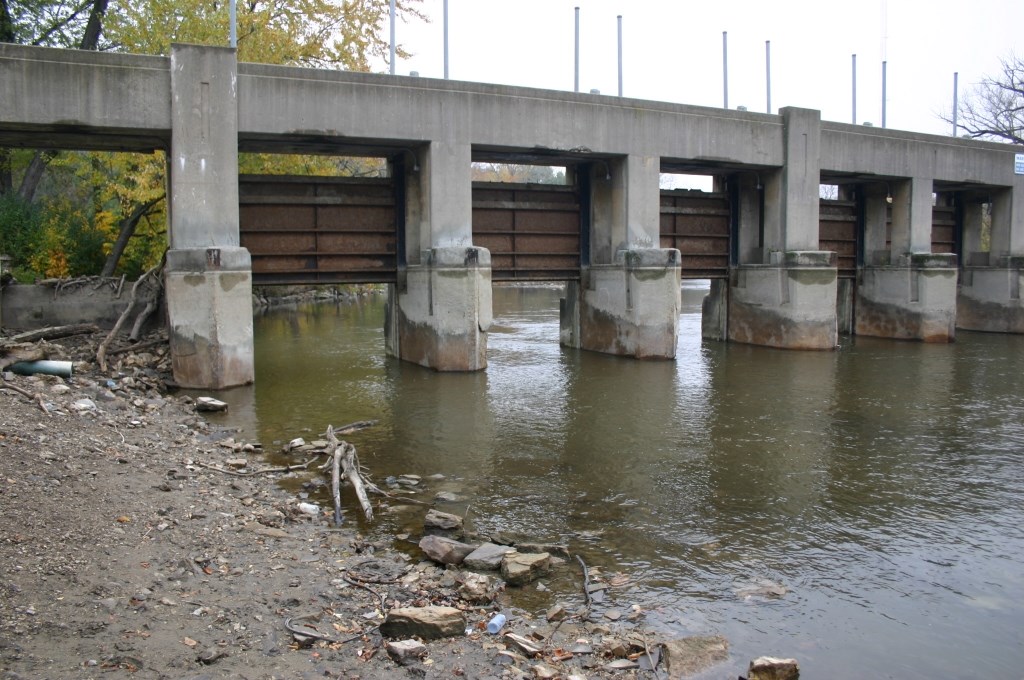Removing the Estabrook Dam will not cost taxpayers 13 million dollars
Claim by homeowners organization that removing the dam would cost taxpayers millions is questionable at best.
In a recent press release published on Urban Milwaukee, the Milwaukee River Preservation Association (MRPA) claims removing the Estabrook Dam could cost Milwaukee County over $12 million dollars due to property value claims. While the MRPA group, a small group of mostly homeowners willing to waste County public taxpayer dollars to repair the Dam for their own private benefit, is allowed to file a claim if the Dam is removed, the legitimacy and credibility of the claim is questionable at best—and, thankfully, Milwaukee County knows it.
So why is Milwaukee County so resoundingly unstirred by the threat from MRPA? Because all of the facts and best information available, including peer reviewed studies of examples of successful small dam removals in Wisconsin with no property value loss, tell us making a claim for loss in property value after small dam removal is baseless.
The valuation of property loss cited by MRPA was carried out by its members, not credible property valuation experts. In fact, in a November 2015 email to all Milwaukee County Supervisors, the Milwaukee County Corporate Counsel referred to this property value assessment as “laughable”. No dam owner in Wisconsin has been legally liable to upstream property owners when a dam is removed to abate a public nuisance. In the end, the best option for improving the health of the Milwaukee River, our fisheries, and public access is removal of the dam.
MRPA’s claim that dam removal cost estimates do not include remediation of County owned property is wrong and misguided. Should the dam be removed, remediation costs can be covered by existing state grants, and the County would also be eligible to receive additional state and federal funding opportunities for water quality and fishery enhancements
While policies are set by governing bodies, including our Milwaukee County Board, a driving principal behind our public participation process is that those policies can and should change based on the best information available and the concerns expressed by all residents affected by the policy.
Our past and current publicly elected Milwaukee County Supervisors have never had the opportunity to cleanly vote on whether to repair or remove the Estabrook Dam through vetting by a Committee and referral to the Board. Chairman Theodore Lipscomb has always managed to tie funding for the Dam to “must-pass” budget resolutions. In 2015, Lipscomb tied repair of the dam to a vote to allocate funding for all County capital construction projects, and in 2016, he suspended the rules of the County Board to tie a vote on dam repair to a vote on funding for the Sheriff’s office.
Our Milwaukee County Board of Supervisors should listen to its own Parks Department, engineering experts, the City of Milwaukee Common Council, the Village of Shorewood, the Milwaukee Metropolitan Sewerage District and more than 1,600 residents who have ALL repeatedly expressed that the best option for Milwaukee County and the environment is to remove the Estabrook Dam once and for all.
Milwaukee County Board Chairman and Supervisor Jason Haas (Chair of the Parks, Energy, and Environment Committee) should schedule a vote on the resolution presented to them by the Department of Parks, Recreation, and Culture asking the Board of Supervisors to approve removing the Estabrook Dam.
NOTE: This press release was submitted to Urban Milwaukee and was not written by an Urban Milwaukee writer. While it is believed to be reliable, Urban Milwaukee does not guarantee its accuracy or completeness.
Mentioned in This Press Release
Recent Press Releases by Milwaukee Riverkeeper
Let Our Rivers Unite Us!
Apr 11th, 2024 by Milwaukee RiverkeeperMilwaukee Riverkeeper Spring Cleanup Event Slated for April 20, 2024
Milwaukee Riverkeeper Annual Report Shows Improvement in River Health
Jan 19th, 2024 by Milwaukee RiverkeeperAnnual report celebrates progress and highlights efforts to restore and reconnect rivers to improve water quality in Milwaukee River Basin




















In a recent press release published on Urban Milwaukee, the Milwaukee River Preservation Association (MRPA) claims repairing the Estabrook Dam could cost Milwaukee County over $12 million dollars due to property value claims.
Shouldn’t the word “repairing” be replaced with the word “removing”?
Yes. fixed
If Hillary and Donald know what is good for them, they will avoid this dispute.
Now to just remove the man made dam in Kletzch Park and the river will finally be wild through Glendale!
Prior to retiring after 38 years with the Wisconsin DNR as a water resources and fisheries biologist, I was involved with numerous dam management and assessment projects in the Milwaukee River Basin, 14 of which ended with the dam owner’s decision to remove a dam in lieu of repair. In each instance, the dam owner weighed the socio-economic and environmental costs and impacts for repairing, removing or other dam management alternative. In almost all instances, the two issues that weighed heaviest for a dam owners decision to repair or remove their dam included the economic cost, and the threat of law suits by riparian’s to maintain a dam in perpetuity to maintain exclusive uses and water-based property values.
With regards to the economic costs, it’s a no brainer. The higher than estimated July 2016 contractor bids and project over sight costs have pushed the capital costs for repair and construction of a fish passage facility to over $4.1 million, or over $600,000 more than the County had funds for. Just as significant, the 20-yr total present worth cost (operation and maintenance, interest on debt) is now more than $6.8 million, something the next generation will be on the hook for. The estimated annual cost to operate and maintain (O&M) the dam and fishway was estimated at $160,000. I believe the annual cost of $50,000 just for debris removal is significantly underestimated since estimates did not include the fixed crest section of the spillway which accumulates the lion’s share of debris and requires more difficult access via a private easement. Even with these repairs, in 20 years the dam will be 100 years old and the gated section of the spillway will likely require major work again if not a complete demo and replacement dwarfing the cost of current day repairs.
Perhaps if the costly repairs actually added value to the river and County residents as a whole it would be a worthy investment. However, the dam repair’s negative environmental and recreational impacts far exceed the benefits. For just a few examples, contrary to dam repair proponent arguments, the dam increases flooding and drainage problems, and the potential liability of flood damages for the County. Also, the DNR’s will no longer allow the County to continue its decades-long practice of opening the gates and draining the impoundment for seven months of the year. This former practice flushes sediment downstream and desiccates fish and wildlife habitat in the drained 100-acre impoundment. Absent the ability to flush the on-going accumulation of sediment, it will fill with polluted sediment at a faster rate, become a fetid pool and eventually limit recreational navigation. To think the federal, state and county just spent $49 million to remove 170,000 cubic yards of polluted and hazardous sediment, equal to 17,000 trucks. Only Carp and some (not all) of the 160 riparian landowners favor the publicaly subsidized dam repair option for the exclusive purpose of operating deep drafting power boats and PWC (e.g., jet skis). The onetime cost for removal of the dam is $1.6 million with most of the costs available from grants. For a detailed assessment of the costs and benefits for the various alternatives see the following link.
https://static1.squarespace.com/static/55157271e4b0179c6ec8b662/t/56e342154c2f8502d979d2aa/1457734177488/EstabrookDam_ver_FINAL+03112016.pdf
I am not an attorney nor are members of the Milwaukee River Preservation Association (MRPA). Based on my participation in other dam removal projects since 1987, the Milwaukee Riverkeeper and the County’s own Corporate Counsel are correct in arguing that the County is not liable for maintaining a nuisance dam and artificial water levels in perpetuity, lost water-based uses and real or perceived loss in property values. There are a number of court decisions that are relevant to the issue, most recently
https://www.wicourts.gov/ca/opinion/DisplayDocument.pdf?content=pdf&seqNo=94669
Contrary to dam repair proponents, there never was a historic “natural lake” and water level. Prior to river channel work and construction of the dam, water levels were 0.5 ft lower than with the dam. Moreover, the impoundment is wider by up to 350 feet, longer by 1 mile and larger by 38 acres (or 29 football fields) compared to the original pre-dam river.
The Estabrook Dam in the past has played a major role in regulating the water levels of the Milwaukee River at Lincoln Park. With the dam gates open, the river is considerably shallower and narrower. The stretch of the river between the Blatz Pavilion and the I-43 bridge is at most times only ankle deep unless there has been very significant rainfall or a heavy spring runoff.
Lincoln Park is a public park for all residents of Milwaukee County and visitors. Its long western border on Green Bay Avenue and the shorter northern and southern borders abut residential neighborhoods. The Green Bay Avenue neighborhood has a predominately minority population. At the recent National Night Out in Lincoln Park, many residents commented that they are no longer able to use the Milwaukee River in the Park the way they did before the dam gates were kept open. The fishing has deteriorated. The river is not as accessible because the banks stretch further out into the river and are, in some places, uneven. It is difficult if not impossible to boat on water in the large areas that are extremely shallow. The Blatz pavilion, which was once heavily used because of its aesthetic appeal, with steps leading directly to the water’s edge, is now under-utilized as the steps now lead to a large seeded grass area bordered by a line of weeds on the river’s edge. Simply drive, or better yet, bike or walk through the park and you will see these changes.
The argument that repairing the dam is only for the benefit of the property owners up river from the dam is not true. Or do we not consider Lincoln Park important because it was and is still used primarily by minority Milwaukee County residents? Would dam removal even be considered if the Park bordered a wealthy white community?
Much of the “news” we are getting about this dam is a product of a paid PR campaign hired to by the Riverkeeper and political cronies. Mainstream print media is involved and has repeatedly disregarded any corrections to their ignorant reporting and dismissed opposing perspectives as uninformed or self-serving. Costs and cost criteria, water quality, reporting and even Chris Abele’s claim that the lake only benefits a few wealthy folks is simply bunk. About 74% of the frontage in the area upstream from the dam is parkland or government owned. The video of the river that Abele used wasn’t even taken in Wisconsin.
About $5Billion was already spent to clean up this Milwaukee River system. Over the past years our government spent $32Million to clean this small area with the goal of fishable, swimmable water. It would be a shame to forever drain this lake that has been in place since the last ice age. Since they opened the dam and dropped the water elevation, it is so shallow and putrid with algae and weeds that swimming isn’t possible or safe and many species of fish can’t survive. Much of the former lake is now dry land. The area off Lincoln Park where water ski shows used to be held is mostly gone or ankle deep.
We need to protect the only inland lake in our county big enough for members of the public to use their own row boats. Other counties have many. All agree that the body of water was a natural lake until the government built some major landscaping, including the Estabrook Dam, so floods in the area could be controlled. The lake hasn’t been used much lately because the dam has been ordered to be open by the DNR, which drained the water so low that boating or even kayaking from one end to the other of the main channel isn’t an option during the summer. With the big PCB removal completed, the lake could become a major recreational feature again if the dam were operated again.
Riverkeeper and their National public relations firm would like us to believe the water quality improved with the dam opened and lower water levels but years of MMSD water testing data disagree. Look west next time you drive over the the I-43 bridge and you’ll see it choked off with garbage trapped in weeds and algae. This stuff wasn’t here before the dam was drawn down. Riverkeeper would also like us to believe removing the dam costs less that restoring it, but as with other dams, upstream restoration costs are many times higher than actual removal costs, especially with the $13M lawsuit from upstream property owners,. Numerous sources including the same property value study cited by the Riverkeeper, warn that navigable, swimmable waterfront property could be severely affected by dam removal. If the dam is removed, those folks are going to sue over water rights which are clearly established.
This struggle has been going on since 2008. This year, when repair opponents lost and the repair was inevitable, Abele’s people manipulated the bidding process. Of 14 otherwise qualified contractors, all but two were eliminated from even bidding on the job. The Abele led County Parks Department changed and stalled the project to be over budget. They shortened the repair period so much and added such unusual requirements that deadline completion concerns, worker overtime costs, and unlikelihood of acceptable results inflated the cost of repair. Money budgeted could no longer pay for the project as it was absurdly requested. One of the silly and costly options they recently added, was a boiler and heating system This idea was tried but never worked in the original dam back in the 1930s. (bubbling systems are a fraction of the cost to build and operate, more reliable, and more common)
Regarding flooding and FEMA flood insurance concerns, the MMSD submitted to the court that if the dam were removed, no existing building would be removed from the floodplain. They also wouldn’t be removed from costly flood insurance expenses. The quote says “These reductions in flood elevations do not remove these structures from the floodplain but do significantly reduce the risk of flood related damage” if the dam were taken down.
In short, the environmentally friendly, lower cost, more natural, and flood safe claims of repair opponents are not true and when someone continues to repeat untrue statements, they are liars.